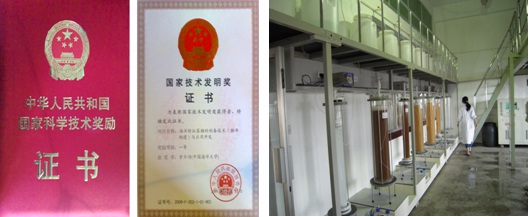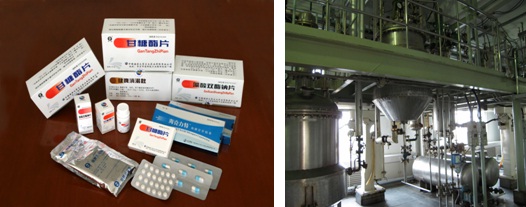China,a major country in seaweed cultivation, has formed a mass seaweed cultivation chain focusing on kelp, purple seaweed, and agar-agar. A seaweed industry therefore took shape in the 1970s. In 2006, the exports of algin, agar, and Carrageenan from China comprised 70% of the world market share. However, the rudimentary use and low-value application of the above-mentioned have become the bottleneck to the development of the seaweed industry. With the rapid development of Glycobiology, people have realized the uniqueness of many polysaccharide units, and the nonuniformity of their structures, and also the ionic features of overall structure, which embodies huge potential in its application. Therefore, conducting research on its high-value application not only meets the demands of boosting industrial development, but also the demands of furthering scientific research. The project has established a set of technological systems for its high-value application development, which include:
1. A technological system has been established for the mass production of targeted marine oligosaccharides. a). 15 kinds of polysaccharide hydrolysis enzymes of high activity and high product specificity with intellectual property rights owned by Ocean University of China (OUC) were discovered (invented) and prepared. An oligosaccharide-oriented preparation technology that is effective and controllable, was formulated, thus changing the status quo in which the application development of saccharide is still in the mixture stage, paving new ways for oligosaccharide monomer application.
b). The chemical preparation method for odd- and even-numbered marine sulfuric acid oligosaccharide was invented. A mass preparation technology for polysaccharides was established that is regionally selective and chemically controllable, transforming the convention that chemical degradation of polysaccharides is not selective or controllable.
c). A mass preparation method was invented that could realize the degradation of Chitosan oligosaccharide and its chemical derivation simultaneously, resolving the issue of degradation and separation during mass production.
2. An integration technology system has been launched for the first time to conduct mass-directed separation and structural identification of different oligosaccharides, which gave rise to the first Marine Oligosaccharides Bank in the world. Based on the structural features of these four oligosaccharides, a technology system was established to carry out directed-separation and both online and real-time analysis of the purity and sequence structure of oligosaccharides. This includes modern separation technology for integrated membranes, absorption, distribution, gel exclusion, and ion exchange, according to the different features of oligosaccharides. Upon this the foundation of the world’s first Marine Oligosaccharides Bank was built, containing 164 oligosaccharides with identified structures in 21 series, and 145 glycoconjugates, among which 98 were reported for the first time in the world.
Several relations between marine oligosaccharides and bioactivities were discovered. The technology for directed molecule modification of oligosaccharides (as medicines and functional products) was established, thus solving such major technical problems as high-value utilization for marine oligosaccharides, especially in the production of semi-synthetic drugs made from oligosaccharides. Three marine drugs made from oligosaccharides (approved by the drug regulatory committee: X-180; approved by the Food and Drug Administration: B20020216 and B20020359) were developed, along with a series of functional products, using such molecule modification technologies as control of molecule size and ionic strength.
As many as 118 academic papers have been published and included in the Scientific Citation Index (SCI), and 25 national patents have been granted. Furthermore, four first-level marine oligosaccharides drugs (serial number of approval for clinical research: 2003L00858; 2004L04535; 2005L00087; 2006L02492) are in the clinical research stage, which demonstrate great potential for application and further development. The project provides not only the theoretical and technical support for the high-value utilization of marine oligosaccharides, but also the rare model molecule for further research. It will surely sustain the development of the seaweed industry.
This achievement has won the first prize of the National Award for Technological Invention in 2009.

Certificate Separation and Purification Column for Oligosaccharides

Manufactured marine drugs in this achievement (L)
Large scale preparation workshop of oligosaccharides (R)